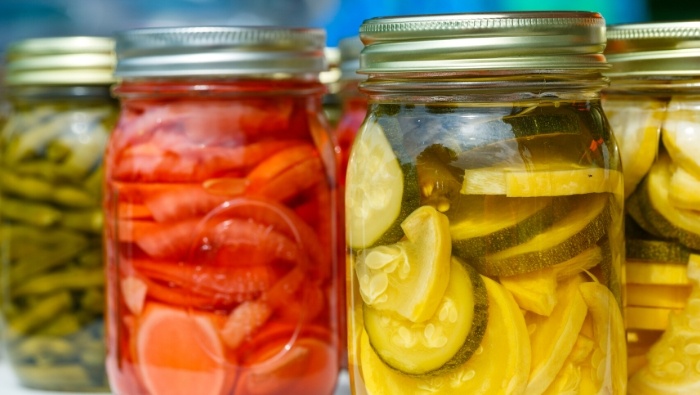How Much Can Preserving Foods Save You?

You may be surprised at how much a little food preservation education can save you. Here are three food preservation methods that can greatly reduce food waste and food bills.
One of the worst feelings you can experience is having to throw away food, especially when you are on a budget.
If you experience this feeling on a regular basis, you are not alone. According to the USDA, roughly 30% to 40% of all food purchased in the United States is lost to waste with 218 pounds of food per person being tossed in the landfill each year. This means, on average, each household throws away at least $2,200 in food annually!
If saving money and preventing waste is important to you, learning the right way to preserve your food should become your primary focus. Here are the three recommended storage methods and how to utilize them.
Drying Foods
Dried foods tend to take up less room than canned or frozen foods, so this is typically the chosen method of preserving foods in areas where there is limited storage space. When you are drying foods, it is important to select vegetables when they are ripe. This is when they have the best flavor and the nutrition quality is at its peak.
Drying your own foods at home is simpler and cheaper than you may think. You really don’t need any special equipment, and in most cases, an oven set at a low temperature will do the trick. All you really need to have on hand is a clean cookie sheet with parchment paper.
If you want to learn more about drying your own foods and what foods can be dried, the University of Minnesota has some great reference material. If you prefer, you can purchase a high-quality food dehydrator for less than $100 online.
Drying food allows you to store it in an airtight container in a pantry or basement. The best way to store your dried produce is in a vacuum sealed bag with a paper towel to absorb any additional moisture that may have crept into the bag. You do not need to refrigerate the food, which is an added bonus.
Sign Up for Savings
Subscribe to get money-saving content by email that can help you stretch your dollars further.
Twice each week, you'll receive articles and tips that can help you free up and keep more of your hard-earned money, even on the tightest of budgets.
We respect your privacy. Unsubscribe at any time.
Canning Foods
Canning food is a practice that allows you to store more than just plain fruits and vegetables. It allows you to precook entire meals and have it ready to heat and eat. Foods like pasta sauces, meats, pie fillings, jellies, jams, side dishes, and more can be waiting for you to use them in your next recipe. All the love of a homemade meal can be ready for a quick toss together when you arrive home from work.
There are two methods of canning foods, which depend greatly on the food’s classification. To properly can foods, you will need some equipment, but almost all of it is reusable.
To can foods you will need, a boiling water canner, a pressure canner, canning jars, a timer, tongs, a funnel, and a few hours of free time. While the initial cost to start canning can be $100 to $250, it is well worth the money spent. This small expense can save you thousands of dollars in a single year. If you prefer, you can start out with basic equipment and upgrade to higher quality with the money you save.
If you are ready to get started on your canning adventure, the National Center for Home Food Preservation is the perfect guide to get started.
Freezing Foods
If you have a large freezer and plenty of space to keep your vegetables, freezing may be the method you prefer to use in preserving your vegetables and fruit.
Even though freezing foods is a great way to preserve food, you do lose some flavor and some texture. Foods that are grown in poor soil or are grown with chemical insect repellents, lack nutrition and lack the necessary stability to survive blanching and freezing.
In freezing, there are some negative effects on the concentration of vitamins. Typically the vitamins that are lost are vitamin C, Vitamin B1, and folic acid. There is not a huge impact on the amount, but you will need to ensure that you eat more of the vegetable to even out the nutritional value.
Between 1960 and 1970, the number of households preserving their own food decreased, causing an increase of 204% in food waste. Since 1990, this amount has increased by an additional 50%. If properly educated in preserving food, the average household could dramatically reduce the amount of food waste they experience, saving money, time, and growing efforts.
If we could reduce the amount of food waste by 15%, with current growth trends, we would save enough food to feed 25 million Americans each year.
Reviewed July 2023
Wouldn't you like to be a Stretcher too?
Subscribe to get our money-saving content twice per week by email and start living better for less.
We respect your privacy. Unsubscribe at any time.
Popular Articles
On After50Finances.com
- 9 Things You Need to Do Before You Retire
- You Didn’t Save Enough for Retirement and You’re 55+
- When Empty Nesters Reorganize and Declutter Their Home
- Reinventing Your Career in Your 50s or 60s
- What Mature Homeowners Should Know about Reverse Mortgages
- 2 Reasons to Collect Social Security Benefits As Soon As Possible


